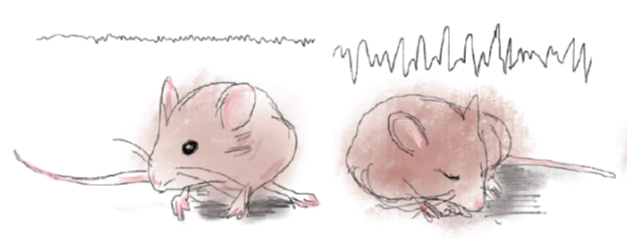Research
Neural Activity Patterns Specific to NREM Sleep, OFF Period
Sleep in mammals is divided into Rapid Eye Movement Sleep (REM), in which we dream, and Non-Rapid Eye Movement Sleep (NREM), in which we lose consciousness. We focus on NREM sleep, the deep sleep that accounts for 80% of sleep. During wakefulness, neurons in the cerebral cortex, which are responsible for higher cognitive functions, can fire whenever they receive the appropriate input. In contrast, it is known that during NREM sleep, many cortical neurons cease their activity at once, and this period of inactivity is called the OFF period. The OFF period has a significant effect on the spatiotemporal pattern of neural activity. It is thought that the OFF period, observed only during NREM sleep, may interfere with conscious sensory perception and cognitive function during wakefulness. We are trying to clarify the mechanism by which this OFF period appears during NREM sleep.

Control mechanisms of sleep and wakefulness as individuals
Sleep is a biological phenomenon that involves changes at the individual level, such as changes in locomotion and cognitive function. On the other hand, the entire brain does not uniformly contribute to the sleep-wake state. So far, several brain regions have been identified as "sleep-promoting" or "wakefulness-promoting" regions. This means that other areas of the brain have no effect on sleep and wakefulness. We are working to quantitatively analyze which regions of the brain are the most important. We are also hypothesizing that the "sleepiness" that accumulates as wakefulness persists (hereafter referred to as "sleep pressure") affects these most important regions. We are now analyzing what changes occur in these brain regions when sleep pressure is increased in mice during sleep deprivation experiments, and what happens in these brain regions as sleep pressure is relieved by subsequent deep sleep, from two perspectives: neural firing frequency and gene expression patterns.
For neurons, firing is a major output means of sending information to other cells. In addition, firing is an energy-consuming event that is tightly regulated in each cell. It is well known that firing changes the transcription of the cell, while the set of genes expressed defines the function of the cell. We are now exploring the role of this interaction between firing and transcription in the control of sleep and wakefulness. By carefully observing the changes that occur in the brain, we can get a closer look at the mechanisms and functions of sleep.